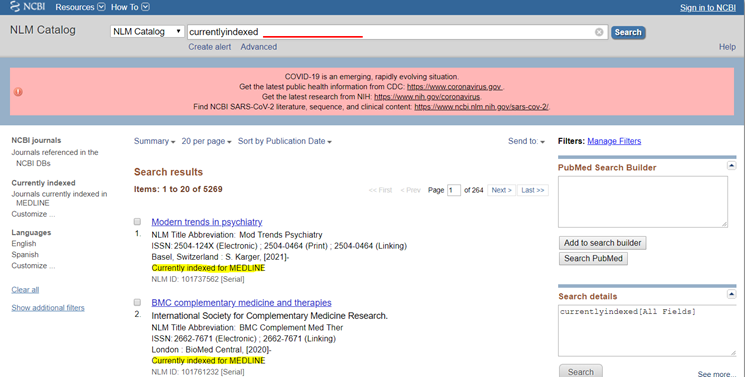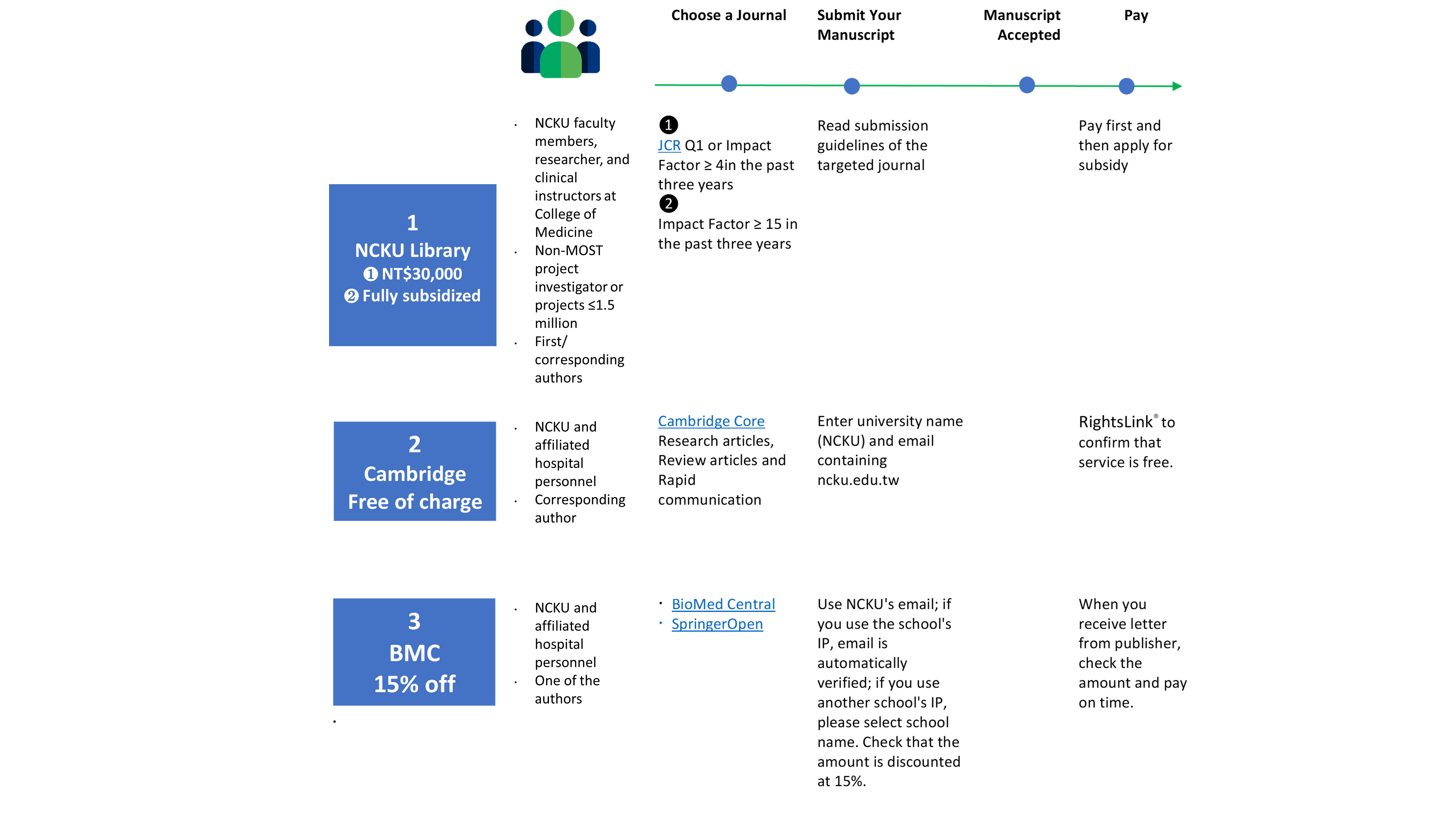Today's Hours:08:20-21:30
>>
Research Guides
Publishing in open access journals requires authors to pay Articles Processing Charge (APC) so that their works are made freely available online to promote the exposure of their academic research.
The rise of open access publications, however, also gave rise to the so-called predatory publishers/journals who aggressively publish open access articles purely for profit. They charge expensive publication fees to authors without checking articles for quality and legitimacy.
In this guide, we introduce a whitelist and blacklist of journals/publishers to prevent predatory publishers/journals, tools for choosing which journals to publish your articles, ORCID registration and authorization, subsidies and special offers for open access publications, and information on submitting your manuscripts for publication.
Whitelist
The following scenario is based on a true story and is probably happening around you right now: "There was a doctor who is a part-time lecturer at a medical college and also a young academic researcher. He received a letter from a top impact factor journal, inviting him to submit his manuscript for publication. Believing that the journal is worthy of his research, the doctor gladly submitted his manuscript to the journal. The doctor quickly received a reply accepting his paper but was asked to pay a hefty handling fee. Feeling suspicious, the doctor made inquiries with his librarian friend only to find that the journal not only had no impact factor at all, but is likely a scam, making him all the more anxious to retract his paper. Not long after that, he received an international call from the publisher, urging him to pay the fee and telling him that the price is negotiable but if he fails to pay then they will publish his work. That is his valuable research..."
Before submitting your paper for publication, you should choose a publisher/journal from the whitelist according to your ideal goals or reward unit standards and simultaneously check and verify the "grey list" of suspected predatory journals to assess potential risks. If a journal is whitelisted or greylisted, you should discuss with your advisor or peers or check online reviews before deciding whether to submit your paper to that journal.
The table below provides web links to the whitelist and greylist of journals/publishers. You can start searching by entering the name of the journal, its ISSN, and the journal's web address.
| Whitelist of Journals/Publishers | ||||||
|---|---|---|---|---|---|---|
| JCR | SCIE & SSCI: Web of Science |
SCIE & SSCI: Master Journal List |
Scopus | MEDLINE Ccurrent Indexed Journals |
Embase Download a List |
DOAJ |
| 😊 | 😊 | 😊 | 😊 | 😐 | 😐 | 😊 |
| Greylist of Suspected Predatory Journals/Publishers | ||||||
|---|---|---|---|---|---|---|
| Beall's List: Publishers | Beall's List: Standalone Journals | JCR Title Suppressions/Editorial Expression of ConcernList |
DOAJ List of non-DOAJ indexed journals |
|||
| 🙁 | 🙁 | 😊 | 😊 | |||
You can make a note of the verification results:😊 Indexed (current), not greylisted; 😐 Not whitelisted; 🙁 Greylisted
When using a search engine or email web link to browse a journal website or journal white/greylist website, you must check whether the website is legit.
Credible index databases or lists are regularly reviewed and updated. Please check whether a journal is indexed before submitting your paper, so as to avoid greylisted journals in disguise. If a journal is published infrequently (e.g., annually or semi-annually), it might no longer be indexed once you successfully submit your paper.
The various research rewards, teacher promotion, and research project applications, etc. are based on verification information from the following lists. Please see the relevant organizer's most recent announcement for the actual guidelines used.
Journal Citation Reports (JCR) provide information on various types of indicators for journals indexed in SCIE and SSCI. JCR publishes data for previous years in July of every year. These data include journals' impact factor, which represents the number of times an article is cited over the past two years. The number of articles and citations is based on over 12,000 journals rigorously reviewed and indexed in SCIE and SSCI every year. This important source is deemed as a key indicator. In JCR, you can also tick the option to display only open access journals. Where necessary, please also check JCR's Title Suppressionslist,JCR'sEditorial Expression of Concernlist.
JCR is updated annually, making it impossible to check whether a recently published article is still indexed. Therefore you can also use the Master Journal List or Web of Science to check whether a recently published article is still indexed.
MEDLINE is a periodical index database most commonly used in the medical field. If you want to make your articles more visible, you should look for journals currently indexed in MEDLINE. As shown in the screenshot below, leave a space after "currently indexed" in the search field, and enter the journal's name or ISSN to check whether the journal is currently indexed.

DOAJ provides a list of high-quality, peer-reviewed open access journals. It can be used to search for detailed information on open access journals and information on journal articles. The website has also organized a List of non-DOAJ indexed journals.
Verifying Lists of Suspected Predatory Journals/Publishers
1.Invitation for manuscript submission from unknown sources-Authors who succeed in submitting their article for the first time are especially prone to receiving invites to publish their manuscript in international journals or conferences.
2.Alternative Impact Factor-Predatory journals frequently claim to have impact factor (IF). They use IF calculation formula but the scope of journals they take into account is completely different. For example, OMICS's Journal of Neonatal and Pediatric Medicine (ISSN:2572-4983) claim to have a journal impact factor of 0.8823, but on another web page, it says in an inconspicuous area that the journal's impact factor is based on the number of times cited by Google Scholar, and further analysis reveals that Google Scholar did not cite the journal at all.
3.Journals with the same name but different publishers-For example, Neuropsychiatry published in Open Access Journals Neuropsychiatry (ISSN:1758-2008)claims to have an impact factor (IF) of 4.778 in 2016. However, another journal with the same name and ISSN but published by a different publisher had ceased publication in 2015. Because IF was based on the values calculated for the past two years, the IF of this journal is still traceable in the 2016 JCR.
4.Unusual Journal Websites-These websites contain fuzzy images, wrong texts, editors of unknown origin, and a journal's name is inconsistent in the text about the journal. For example, the word "journal" is sometimes included and other times excluded.
5.Review response is unusually fast-So fast it feels like they cannot wait to publish your work. They will even pester you with phone calls to negotiate price or force you to submit if you ignore them.
Created by librarian Jeffrey Beall, the Beall's List of Potential Predatory Journals and Publishers is continuously updated by succeeding supporters, providing web links to relevant news and other important lists. When verifying a journal/publisher, check the list of PUBLISHERS and then check the list of STANDALONE JOURNALS. There are no repeats in these two lists.

Subsidies for submission of open access papers
To encourage open-access publications among scholars at NCKU and thereby promoting academic development to increase the international visibility of authors and NCKU research, the library strives to acquire various types of open access services to lower or waive Article Processing Charge for scholars in financial hardship and promote academic development. For details, see Service Description.

Tools for choosing a journal for submission and publication
Journal selection tools compare source articles of indexed journals based on the title and abstract of the manuscript you uploaded and subsequently provide you with a list of journals that fit your subject area as well as other reference information such as journal impact factor, open access policies and cost, how long a review and publication will take, and manuscript acceptance rate. The journal sources of the journal selection tool are divided into the following two categories:
Indexed journals published by different publishers
EndNote Web: Match (21,000journals. Log in required)
It matches against a list of journals indexed in JCR, which can be imported together with EndNote reference bibliography cited in the manuscript for comparison to improve the relevance of the comparison.
WOS Match Manuscript (21,000journals.Log in required)
It matches against a list of journals indexed in JCR.
JournalGuide (46,000journals)
Indexed journals published by a single publisher: This is a platform created by publishers and therefore, it provides easier access to accurate information on how long a review/publication takes and manuscript acceptance rate.
Elsevier Journal Finder (2,700 journals)
Springer Journal Suggester (2,500 journals)
Instructions to Authors
Instructions to Authors in the Health Sciences
Instructions collected by the Mulford Health Science Library for submitting manuscript to medical journals.